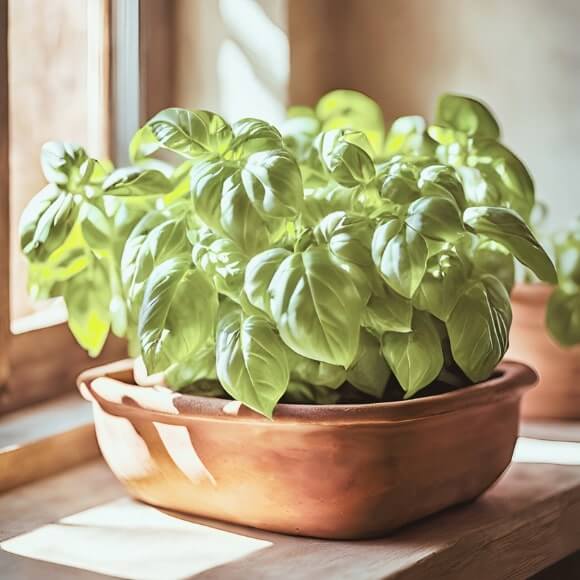Basil (Ocimum basilicum) is one of the most beloved and versatile herbs in the world, often referred to as the “King of Herbs.” Known for its fresh, peppery, and slightly sweet flavor, basil is a staple in many global cuisines, especially in Italian, Thai, and Mediterranean cooking. This aromatic herb is also valued for its medicinal properties, offering antioxidants and anti-inflammatory benefits. Basil is relatively easy to grow and can thrive in gardens, pots, or even indoors with the right care.

Soil Requirements
Basil grows best in well-draining, fertile soil with a neutral to slightly acidic pH, ideally between 6.0 and 7.0. A rich soil amended with compost or organic matter is perfect for basil, as it supports vigorous growth and helps maintain soil moisture. Avoid planting basil in heavy, clay-like soil, as it can lead to waterlogged roots and reduced plant health.
Sun Requirements
Basil loves sunshine and needs at least 6 to 8 hours of direct sunlight each day to thrive. In cooler climates, full-sun exposure helps basil grow strong and flavorful, while in hotter climates, it may benefit from some afternoon shade to prevent the leaves from wilting or scorching.
Watering Requirements
Basil requires consistent moisture but does not tolerate soggy soil. Water basil deeply, ideally at the base of the plant, allowing the top inch of soil to dry out slightly between waterings. Overwatering can lead to root rot, so it’s essential to ensure that basil is in well-draining soil and that the roots aren’t sitting in water. Mulching around the base of the plant can help retain moisture, especially during hot weather.
Best Plant Hardiness Zones
Basil is generally considered an annual in most climates, but it’s a perennial in USDA Hardiness Zones 10 and 11, where temperatures rarely drop below freezing. In zones with cooler Winters, basil should be treated as an annual or grown indoors in a sunny window or under grow lights during the colder months.
Popular Basil Varieties
Basil comes in many shapes, sizes, and flavors, each with unique characteristics that lend themselves to different culinary uses. Let’s take a look at five popular varieties of basil, each with distinctive flavors and applications.
Sweet Basil
Sweet basil is the most common type of basil, known for its bright green leaves and classic flavor profile. It has a sweet, peppery, and slightly clove-like taste, making it incredibly versatile in the kitchen. Sweet basil is often associated with Italian cuisine and is a staple ingredient in pesto, salads, and tomato-based dishes.
Sweet basil shines in fresh preparations like caprese salad and pesto, where its delicate, aromatic flavor can take center stage. It’s also perfect for sauces, soups, and pizzas. Adding fresh sweet basil at the end of cooking preserves its flavor, as high heat can diminish its delicate aroma.
Thai Basil
Thai basil has a distinctive anise or licorice-like flavor, with a hint of spice that makes it popular in Southeast Asian cooking. The leaves are smaller, darker, and sturdier than those of sweet basil, with purple stems that add a pop of color.
Thai basil is a must-have for authentic Thai dishes such as stir-fries, curries, and soups. It holds up well to heat, making it ideal for hot dishes where its robust flavor can shine. Thai basil is also commonly used as a garnish for pho, a popular Vietnamese noodle soup, and pairs well with spicy ingredients and rich flavors.
Genovese Basil
Genovese basil is a variety of sweet basil with a stronger flavor and larger, more crinkled leaves. Originating from Italy’s Liguria region, this basil is highly aromatic and is considered the best variety for making traditional pesto alla Genovese.
Genovese basil’s bold flavor makes it the star ingredient in pesto. It’s also excellent in marinara sauces, bruschetta, and as a garnish for pasta dishes. Genovese basil is best used fresh and pairs beautifully with garlic, pine nuts, and Parmesan cheese, which are classic pesto ingredients.
Lemon Basil
Lemon basil has a unique citrusy aroma and flavor, with hints of lemon zest. It has smaller, lighter green leaves compared to sweet basil, and the refreshing lemony scent is especially appealing in Summer dishes.
Lemon basil is a wonderful addition to seafood, poultry, and vegetable dishes, where its light, citrus flavor can shine. It’s also popular in salads, vinaigrettes, and beverages, adding a refreshing twist to iced teas and cocktails. Lemon basil works well in light sauces and marinades and is particularly delicious in fruit salads or as a garnish for desserts.
Holy Basil (Tulsi)
Holy basil, or tulsi, is a sacred plant in Indian culture and is widely used in Ayurvedic medicine for its health benefits. Unlike sweet basil, holy basil has a slightly spicy, clove-like flavor with a hint of pepper. The leaves are often more serrated, and the plant has a strong aroma.
Holy basil is commonly brewed as a tea and is prized for its adaptogenic properties, believed to help reduce stress and promote overall wellness. It’s also used in Thai cuisine, particularly in spicy dishes like pad kra pao (Thai basil chicken). While it’s less common in Western cooking, holy basil’s medicinal properties have led to its increased popularity as an herbal remedy. ❖


 Previous
Previous

